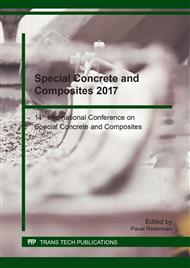[1]
L. C. Bank, Composites for construction: Structural design with FRP materials, New Jersey, (2006).
Google Scholar
[2]
I. Laníková, P. Štěpánek, J. Venclovský, Optimization of a tunnel lining reinforced with FRP, Key Engineering Materials. 691 (2016) 148-159.
DOI: 10.4028/www.scientific.net/kem.691.148
Google Scholar
[3]
M. Saafi, Effect of fire on FRP reinforced concrete members, Composite Structures. 58 (2002) 11–20.
DOI: 10.1016/s0263-8223(02)00045-4
Google Scholar
[4]
M. Zlámal, A. Kučerová, P. Štěpánek, Effect of fire on FRP reinforced concrete structures, in: CESB 2013, PRAGUE, 2013, pp.493-498.
Google Scholar
[5]
F. Girgle, L. Bodnárová, A. Kučerová, P. Janák, J. Prokeš, Experimental Verification of Behavior of Glass and Carbon Fibers in Alkali Environment, Key Engineering Materials. 677 (2016) 43-48.
DOI: 10.4028/www.scientific.net/kem.677.43
Google Scholar
[6]
B. Benmokrane, P. Wang, T. M. Ton-That, H. Rahman, J. F. Robert, Durability of Glass Fiber-Reinforced Polymer Reinforcing Bars in Concrete Environment, J. Compos. Constr. 6 (2) (2002).
DOI: 10.1061/(asce)1090-0268(2002)6:3(143)
Google Scholar
[7]
B. Benmokrane, F. Elgabbas, E. Ahmed, P. Cousin, Characterization and Comparative Durability Study of Glass/Vinylester, Basalt/Vinylester, and Basalt/Epoxy FRP Bars, J. Compos. Constr. 19 (6).
DOI: 10.1061/(asce)cc.1943-5614.0000564
Google Scholar
[8]
V. M. Karbhari, (Ed. ), Durability of composites for civil structural applications, Elsevier, (2007).
Google Scholar
[9]
V. Dejke, Durability of FRP reinforcement in concrete, Ph.D. thesis, Dept. of Building Material, Chalmers Univ. of Technology, Sweden, (2001).
Google Scholar
[10]
Y. Chen, J. F. Davalos, I. Ray, H. Y. Kim, Accelerated aging tests for evaluation of durability performance of FRP reinforcing bars reinforcing bars for concrete structures, Compos. Struct. 78 (1), 101–111.
DOI: 10.1016/j.compstruct.2005.08.015
Google Scholar
[11]
M. Robert, P. Wang, P. Cousin, B. Benmokrane, Temperature as an accelerating factor for long-term durability testing of FRPs: Should there be any limitations?, J. Compos. Constr. 14 (4) (2010), 361–367.
DOI: 10.1061/(asce)cc.1943-5614.0000102
Google Scholar
[12]
ACI: Guide tets methods for fiber-reinforced polymers (FRPs) for reinforcing or strengthening concrete structures, 440. 3R-12, Farmington Hills, Michigan, (2012).
Google Scholar
[13]
CSA S806-12 – Design and construction of building structures with fibre-reinforced polymers, Canadian Standards Association (CSA), (2012).
Google Scholar
[14]
ISO 10406-1: 2015, Fibre-reinforced polymer (FRP) reinforcement of concrete - Test methods - Part 1: FRP bars and grids; Geneva, Switzerland, (2008).
DOI: 10.3403/30356320
Google Scholar


